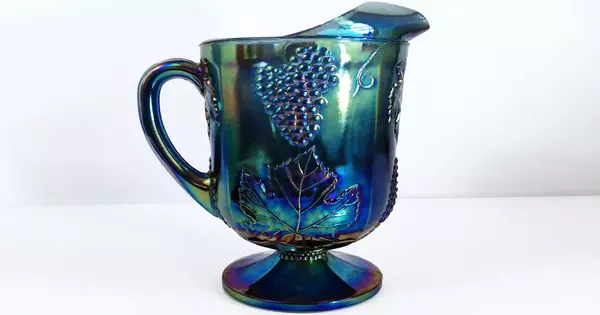Carnival glass is made of moulded or pressed glass with an iridescent surface shimmer. It is a type of ornate glassware that was popular in the United States from the late 1800s to the early 1900s. It has been called aurora glass, dope glass, rainbow glass, taffeta glass, and even ‘poor man’s Tiffany’. It is famous for its brilliant and iridescent colors, which were obtained by putting metallic salts and fumes to the surface of the glass during the manufacturing process. When the glass was heated and cooled, it produced a shimmering, rainbow-like effect that resembled the colors seen on carnival rides, hence the name “carnival glass.”
Collectors used the term “Carnival glass” in the 1950s because pieces of it were occasionally given away as prizes at carnivals, fetes, and fairgrounds. Evidence suggests, however, that the great majority of it was purchased by households to brighten dwellings at a time when only the wealthy could afford brilliant electric lights, as its finish catches the light even in dark corners.
Carnival glass was mass-produced over the world beginning in the early twentieth century, but primarily and originally in the United States. It was at its peak of popularity in the 1920s, and it is being produced in modest numbers today.
Here are some key points about carnival glass:
- Origins: Several glass companies in the United States, including Fenton Art Glass Company, Northwood Glass Company, Imperial Glass Company, and others, pioneered the production of carnival glass in the early 1900s. It was developed as a less expensive alternative to more expensive art glass of the time, such as Tiffany or Steuben glass.
- Iridescence: Carnival glass is distinguished by its iridescent finish, which gives it a rainbow-like shimmer. Iridescence is created by spraying or dipping the glass in a solution containing various metallic compounds, such as metallic salts, which interact with the glass when heated.
- Patterns and Shapes: Carnival glass was produced in a wide variety of patterns, shapes, and colors. Common patterns include grape and cable, peacock, butterfly and berry, and many others. The glassware came in various forms, including bowls, vases, plates, and more.
- Colors: Carnival glass was made in a range of colors, with marigold (a golden-orange hue) being one of the most common. Other popular colors include amethyst, blue, green, and red. The choice of color could affect the value of a piece.
- Reproductions: Carnival glass has been reproduced and imitated in modern times due to its appeal. Collectors must be cautious when determining the authenticity of artifacts because some contemporary goods may replicate the iridescence and patterns of old carnival glass.
Market Value
It is a colorful and decorative type of glassware with a long history that collectors and enthusiasts value for its particular beauty and historical relevance. Carnival glass has a wide range of values, with rare or uncommon pieces commanding greater prices. It is commonly purchased and sold in antique and collector exhibits, as well as online auctions and markets.
















